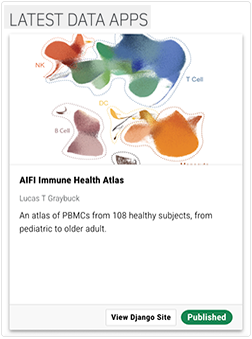Get Started with Data Apps
 | Abbreviations Key |
| AIFI | Allen Institute for Immunology |
| CLI | command line interface |
| dbGaP | Database of Genotypes and Phenotypes (NIH database) |
| DOI | digital object identifier |
| EMR | electronic medical record |
| GCP | Google Cloud Platform |
| HISE | Human Immune System Explorer |
| IDE | integrated development environment |
| IRB | institutional review board |
| NIH | National Institutes of Health |
| ORCiD | Open Researcher and Contributor ID |
| PHI | protected health information |
| ROR | Research Organization Registry |
| UI | user interface |
At a Glance
Data Apps is a dynamic platform that showcases the data and computational resources in HISE, helps scientists explore AIFI experimental data and analyses in context, validates research with Certificates of Reproducibility, and packages assets in a custom-designed UI. This tutorial focuses on how to build and manage a Data App after you understand what Data Apps are and what content they contain. For details, see Explore Data Apps.
Description
Data Apps are built in the HISE Collaboration Space, and they move to the Explore portal after they're approved and published. Presenting your work in the Explore portal lets you showcase your research in an Allen Institute–affiliated space that other scientists can explore. For details about the Data Apps content and UI, see Explore Data Apps. To request a new Data App, contact immunology-support@alleninstitute.org.

Manage Accounts
Anyone who browses Data Apps in the Explore portal can delve into AIFI research, visualizations, or data sets. To re-execute portions of a Certificate of Reproducibility (CertPro), however, you must either be a HISE user or establish a Data Apps workspace guest account.
Manage HISE Accounts
HISE users work with their respective account administrators to track costs and stay within the established cloud computing limits. For details, see the following documents:
Track Your IDE Billing Expenses (Tutorial)
Manage Organizational Billing (Tutorial)
Manage Workspaces
If you're not a HISE user but you want to work with publications or Data Apps, you can establish a guest workspace account tied to your Google Cloud Platform (GCP) billing ID. For details, see the following topics in Manage Workspaces (Tutorial):
Step 1: Set Up a GCP Billing ID
Step 3: Agree to Terms and Authorize Billing
Step 4: Associate Your GCP Billing ID with HISE
After you set up your workspace account, you can view it, give other users permission to access it, and sign out at the end of each session:
Sign out of your workspace account
Manage Plugins and other Components in the Data Apps UI
A Data App can contain a large number of web pages. The look and feel of those pages depends on the nature of the data and the various insights you want to highlight. The Data Apps environment offers a web content management system (CMS) for custom styling of your Data Apps components. In the simplest terms, Data Apps consist of content wrapped in a UI. For an introduction to all Data Apps UI elements, including plugins and templates, see Explore Data Apps Plugins and Other UI Components.
Use the following instructions to add content to your Data App, view it, and delete it if needed. (To add or delete assets, however, your Data App must be unpublished.)
Create pages
If you're comfortable working with code, you can use plugins to create your own page layouts. If you want a head start, you can use page templates instead. These preconfigured pages help you create a uniform look and feel for your Data Apps site. For details, see Manage Pages and Text Elements in the Data Apps UI (Tutorial).
Manage text components
Add an expandable (accordion) box
Use navigational components
To create navigational elements, such as buttons, badges, and links, and visual elements, including image carousels, embedded videos, and icons, see Manage Visual and Navigational Elements in the Data Apps UI (Tutorial).
Use visual elements
Visual elements can be static, such as jumbotrons, or dynamic, such as carousels and videos.
Manage Certificates of Reproducibility
A Certificate of Reproducibility (CertPro) is a detailed record of your scientific research generated in real time to foster reliable reproducibility of study results. This step-by-step trace includes your data, scientific algorithms, computational environment, tools stack, and results.
Certificates are awarded to reproducible file sets, visualizations, and notebooks. Reports and GitHub repositories are not eligible for certification. For details, see the following documents:
Understand Certificates of Reproducibility
Zoom in, zoom out, or fit on screen
Search
Advanced Search lets you specify the samples, subjects, file types, or studies you want to find. For details, see the following topics:
Follow Open Science Best Practices
We respect the principles of open science in everything we do at AIFI. Sharing scientific data is one of our core practices, but such transparency must be balanced with robust privacy measures to avoid exposing research participants' sensitive information.
Data Privacy
Masking metadata is part of AIFI's obligation to earn the trust of the study participants who supply samples and the IRBs tasked with protecting study participants' confidentiality and well-being. The data trace in your Data App's CertPro can be partially masked to protect PHI. For details, see the following topics in Use Deidentified Data:
Attribution
Proper attribution is a core principle of open science. Proper attribution of individual and collaborative work encourages dialog, promotes problem solving, and fosters continued cooperation among scientists, research partners, the wider scientific community, and interested members of public. Data Apps credit authorship of data releases at all levels, including scientific insight, back-end infrastructure development, insights, data sets, and community support efforts. For details, see Manage Attribution in Open Science Publications (Tutorial)
Get Help
For help with any Data Apps question, ping us at immunology-support@alleninstitute.org. We usually respond quickly, especially during core business hours (9 a.m. to 5 p.m. Pacific).
 Related Resources
Related Resources
Request Approval for Data Apps (Tutorial)
